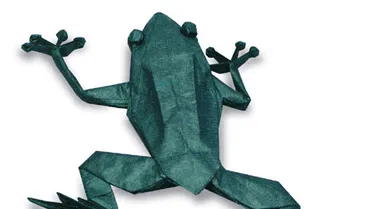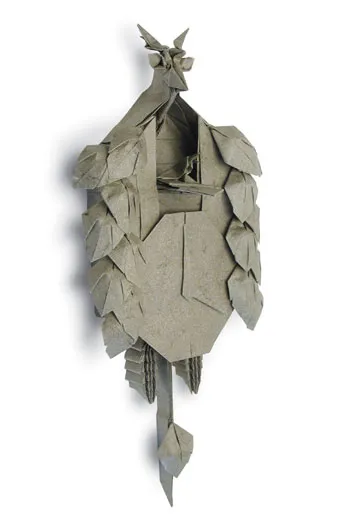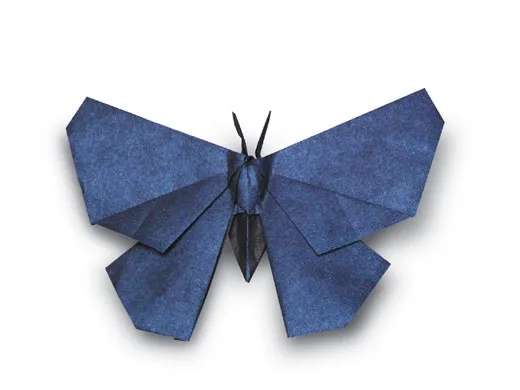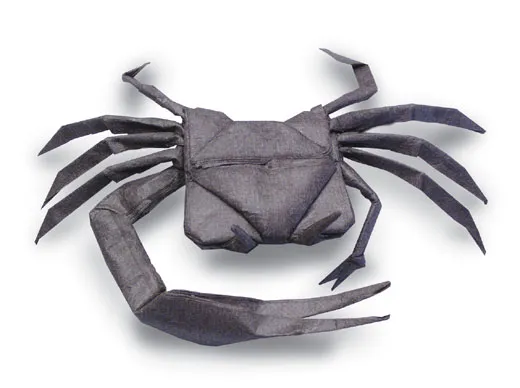Into the Fold
Physicist Robert Lang has taken the ancient art of origami to new dimensions
Among the multilegged creatures in Robert Lang's airy studio in Alamo, California, are a shimmering-blue long-horned beetle, a slinky, dun-colored centipede, a praying mantis with front legs held aloft, a plump cicada, a scorpion and a black horsefly.
So realistic that some people threaten to stomp on them, these paper models, virtually unfoldable 20 years ago, represent a new frontier in origami. No longer limited to traditional birds and boats, origami—the art of paper folding—is evolving artistically and technologically, thanks to a small but growing number of mathematicians and scientists around the world, including Lang. What's more, this group believes the ancient art holds elegant solutions to problems in fields as diverse as automobile safety, space science, architecture, robotics, manufacturing and medicine.
A laser physicist and former researcher with NASA's Jet Propulsion Laboratory, Lang, 46, is a pioneer in technical and computational origami, which focuses on the mathematics behind the art. "He's the Renaissance man of origami," says Jan Polish of Origami USA, which has 1,700 members worldwide. "A lot of people who come from the science end are mostly interested in origami as a problem to be solved. His work is very intriguing because he has combined art and math. His signature is a high degree of reality with a breath of life."
Lang has created or breathed life into more than 495 intricate new origami models, some requiring hundreds of folds: turtles with patterned shells, raptors with textured feathers, a rattlesnake with 1,000 scales and a tick the size of a popcorn kernel. His masterpiece, first created in 1987, is a life-size, 15-inch-tall Black Forest cuckoo clock, complete with pendulum, pine cones and stag's head. It is so complex that Lang was asked to demonstrate its folding on Japanese television—a task that took five hours. Most of these works adhere to one deceptively simple requirement—the use of a single sheet of paper with no cuts or tears.
Lang, who has authored or co-authored eight books on origami, has exhibited pieces in art galleries and at origami conventions in Paris, New York, Tokyo, Boston, Seattle and San Diego. In 2004, he spent a week as artist-in-residence at the Massachusetts Institute of Technology (MIT), where his lectures drew standing-room-only audiences of paper folders and math and computer-science students. This past September, he organized the Fourth International Conference on Origami in Science, Mathematics and Education, held at the California Institute of Technology.
"One of the things that's really unusual about him is his intuition for paper and his technical acuity at folding it," says Erik Demaine, an associate professor in electrical engineering and computer science at MIT who studies all types of folding and is a frequent collaborator with Lang. "When he works on a problem, he usually can see the solution, get out a piece of paper and demonstrate it."
Lang first embarked on his paper route at the age of 6, when his father, Jim, a sales and service manager for an equipment company in Atlanta, and his mother, Carolyn, a homemaker, gave their precocious son a book on origami. "I remember the moment I started," Lang recalls. "This seemed like such a wonderful thing, that you could take some paper, something free, and make really neat toys out of it. There's essentially an endless supply of raw material."
By the age of 10, Lang had folded flapping birds and jumping frogs, and was running out of published models. "I started wanting to make things that weren't in the books, and at some point began making my own designs," he says. He continued folding, and by the time he graduated from the California Institute of Technology—with a doctorate in applied physics—the art of origami was in a resurgence.
No one knows for sure when or where paper folding originated, but it seems to have been well established by the 1600s in Japan, where messages of good luck and prosperity have long been folded into ceremonial pieces. There was also an independent tradition of paper folding in Europe. But until the mid-20th century, practitioners had been limited to only a few hundred classic and oft-repeated designs. Then, in the 1950s, new techniques and designs created by Japanese origami artist Akira Yoshizawa started being published and exhibited. Soon after, experts began working on the mathematics that would allow the design and computation of abstract geometric shapes in folded paper. Lang and others use analytical geometry, linear algebra, calculus and graph theory to solve origami problems.
In the early '90s, Lang and Japanese origami master Toshiyuki Meguro simultaneously hit on a technique that has revolutionized folding. Now called "circle-river packing," the technique allowed origamists to do something that had always eluded them—create models with realistic appendages in specific spots. Each of a design's "flaps"—an area of the paper that is to become a leg or an antenna, for instance—is represented by a circle or a strip. Circles are drawn, or "packed," onto a square piece of paper, like oranges in a crate, with no overlap. The spaces between the circles may contain strips, or rivers, hence the name, circle-river packing. For the first time, designs that existed only in the mind's eye could be reliably reproduced without endless—and sometimes fruitless—trial and error.
Now origami designers like Lang could churn out models of startling realism, including insects, whose many legs, wings and antennae had always thwarted designers. The 1990s became the golden age of insects—known to insiders as the Bug Wars. "Someone would create an insect, then someone else would make one with wings, then someone else would have wings with spots," Lang recalls. "I worked a lot on insects, and in working out those design techniques, I developed techniques that could be used for many subjects."
During the 1990s Lang also developed a computer program that uses circle-river packing to produce sophisticated designs. Called TreeMaker, the program allows artists to draw a stick figure of a desired model on-screen. The software then calculates and prints out the most efficient crease pattern. A second program, called ReferenceFinder, determines the sequence of folds needed to create the model. Lang says he uses the programs only rarely when designing his own pieces, usually when brainstorming the design for the basic structure of a particular model. The computer does the grunt work, kicking out a variety of crease options. Then it's back to pencil and paper and hands-on folding to add the many design subtleties that don't yet exist in algorithmic form.
"I'm not trying to make a photograph, I'm trying to capture the essence, the impression of something," Lang says. "Some subjects I come back to over and over—cicadas, simple birds. I can do them in a different way and get ever closer to my mind's-eye image of what they ought to look like. You wouldn't think that origami could be reduced to equations, but some parts of it can. But the artistic aspect will never be captured in equations."
As it happens, the science and art of complex folding holds the potential of solving problems in sheet-metal, collapsible structures such as solar panels for space applications, and robotic arm manipulation. In medicine, research is under way to develop new blood-vessel stents that can fold up for insertion into weakened arteries, then expand once in place.
At carhs gmbh, formerly EASi Engineering GmbH in Germany, engineers trying to simulate air-bag deployment first had to model the flattening of the bag into its folded form—something their software couldn't manage. A computer algorithm developed by Lang allowed engineers to fold various shapes for simulation. Lang has also consulted with engineers at California's Lawrence Livermore National Laboratory on a new generation space-based telescope dubbed Eyeglass. The goal is to put huge telescopes—up to 328 feet in diameter—into orbit for purposes that include the viewing of planets outside our solar system. Getting such a behemoth into space poses a problem because the hold of the space shuttle measures a slim 15 feet in diameter. Lang devised a folding pattern for a 16-foot-diameter prototype that can be folded for transport, then unfurled like a flower coming into bloom once in space.
Lang is also busy writing a second book on mathematical folding techniques, and designing and folding a gigantic paper pteranodon, whose 16-foot wingspan will grace Redpath Museum in Quebec. "Origami as an art form is radiating in all directions from its beginnings as a traditional craft," he says. "We're still nowhere near the limits of what's possible."
Beth Jensen is a freelance writer based in Pleasanton, California. Despite her interest in origami, she has yet to successfully fold a road map, much less a fiddler crab.



